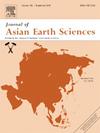Generation of the 2022 earthquake swarm in intersection of four geological units in the seismic experimental Site, southwest China
IF 2.7
3区 地球科学
Q2 GEOSCIENCES, MULTIDISCIPLINARY
引用次数: 0
Abstract
Three adjacent and successive earthquakes with magnitude over 6.0 in the seismic experimental site, southwest China in 2022 were investigated mainly based on multi-disciplinary observation data combined with regional geology. The abnormal variations of GPS horizontal velocity field and cross-fault baselines, seismic activity, and also fluids geochemistry presented strong cascade and pre-, post-, and co-seismic consistency, suggesting these events could belong to one sequence of earthquakes motivated by a lateral expansion of the Tibetan Plateau. Based on comprehensive analysis, the progressive regional localization of deformation and strain in the intersection of the four geological units, subjected to the lateral expansion of the Tibetan Plateau due to the remote action of the India-Eurasia collision, was unveiled to be the tectonic driver controlling the earthquake swarm, and a “south-north–south cascade” model was proposed for the generation process of the earthquake sequence. According to this model, the possible southward stain transfer in the southeastern margin of the Tibetan Plateau should be considered for potential strong earthquakes in the future. Although this study is special for the seismic experimental site, China, it could be inferred that similar processes might be probable elsewhere, thus, prospective transfer direction forecasting for coming seismic activity could be envisaged in some intersections of multiple geological units.

求助全文
约1分钟内获得全文
求助全文
来源期刊

Journal of Asian Earth Sciences
地学-地球科学综合
CiteScore
5.90
自引率
10.00%
发文量
324
审稿时长
71 days
期刊介绍:
Journal of Asian Earth Sciences has an open access mirror journal Journal of Asian Earth Sciences: X, sharing the same aims and scope, editorial team, submission system and rigorous peer review.
The Journal of Asian Earth Sciences is an international interdisciplinary journal devoted to all aspects of research related to the solid Earth Sciences of Asia. The Journal publishes high quality, peer-reviewed scientific papers on the regional geology, tectonics, geochemistry and geophysics of Asia. It will be devoted primarily to research papers but short communications relating to new developments of broad interest, reviews and book reviews will also be included. Papers must have international appeal and should present work of more than local significance.
The scope includes deep processes of the Asian continent and its adjacent oceans; seismology and earthquakes; orogeny, magmatism, metamorphism and volcanism; growth, deformation and destruction of the Asian crust; crust-mantle interaction; evolution of life (early life, biostratigraphy, biogeography and mass-extinction); fluids, fluxes and reservoirs of mineral and energy resources; surface processes (weathering, erosion, transport and deposition of sediments) and resulting geomorphology; and the response of the Earth to global climate change as viewed within the Asian continent and surrounding oceans.
 求助内容:
求助内容: 应助结果提醒方式:
应助结果提醒方式:


